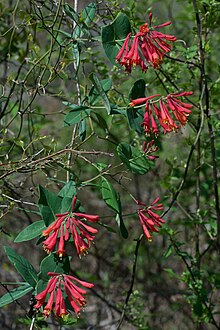Lonicera sempervirens
| Lonicera sempervirens | |
|---|---|

| |
| Scientific classification | |
| Kingdom: | Plantae |
| Clade: | Tracheophytes |
| Clade: | Angiosperms |
| Clade: | Eudicots |
| Clade: | Asterids |
| Order: | Dipsacales |
| Family: | Caprifoliaceae |
| Genus: | Lonicera |
| Species: | L. sempervirens
|
| Binomial name | |
| Lonicera sempervirens | |
Lonicera sempervirens(commonly known ascoral honeysuckle,trumpet honeysuckle,orscarlet honeysuckle) is a flowering plant species ofhoneysucklevine native to the eastern United States which is known for its reddish flowers.[2][3]
Description
[edit]Lonicera sempervirensis best recognized by trumpet-shaped and coral to reddish flowers. The leaves and stems are waxy, a common trait in thehoneysucklegenus.[citation needed]It is a twiningvinegrowing to 20 ft or more through shrubs and young trees. The leaves are produced in opposite pairs, oval, up to 5 cm long and 4 cm broad; the leaves immediately below the flowers areperfoliate,joined at the base in a complete ring round the shoot. When born, their flowers are whorled on the end.[4]They are present with red berries on them that are less than 1 cm width and length.[5]The berries are inedible and grow from summer to fall.[5]Their leaves are somewhat evergreen.[6]The species is also flammable, which leads to it not being recommended for being planted close to residences.[5]The flowers are produced on new growth in clusters of several groups of three together, tubular, 5 cm long, with five small lobes opening at the tip to expose the stamens and stigma. The bark is green and fuzzy when younger but becomes a light brown as it ages.[5]The older stems get more of a red-orange color.[4]
Distribution
[edit]Lonicera sempervirensis most common in eastern North America, but has occurred as far west as Texas.[2]It is found prominently in the southeastern United States.[2]It is listed as endangered in Maine, the only state in which it has any legal status.[2]Although introduced in parts of New England, populations ofL. sempervirenshave been found that seem to be growing natively in Connecticut, Massachusetts, and Rhode Island.[7]It is considered extremely rare in Rhode Island.[7]Lonicera sempervirensis most common in coastal habitats.[5]
Taxonomy
[edit]Lonicera sempervirenswas first described by Swedish botanistCarl Linnaeusin his treatiseSpecies Plantarumin 1753. Varieties ofL. sempervirensareLonicera sempervirensL. var.hirsutulaRehder,Lonicera sempervirensL. var.minorAiton, andLonicera sempervirensL. var.sempervirens. Phenianthus sempervirens(L.) Raf is asynonym.[2]Hybrids of the species includeLonicera × tellmannianaandLonicera × heckrottii.[8][9]
Uses
[edit]Lonicera sempervirensis often used as an alternative to the invasiveLonicera japonicaacross the east coast ofNorth America.[2]It is popular to grow in gardens or recreational areas as it is considered low maintenance.[5]It is also used to attract hummingbirds and butterflies for pollinator gardens.[5][10]The species is mainly used ornamentally on fences or lattices, and for the attractive red color of its flowers.[10]It can be propagated by either stem cutting or by seed,[5]and has been used to treat asthma and bee stings in Native American traditions.[10][11]There are a few different cultivars including: 'Magnifica' which blooms later and is more floriferous, 'Sulphurea' with sulfur-yellow flowers, and 'Superba' - another floriferous selection with bright red flowers.[12]
Lonicera sempervirenscan grow in many areas due to its cold hardiness,[13]being winter hardy in USDA zones 5-9.[14]It prefers sunny and moist areas but is also drought resistant.[15]Coral honeysuckle can live inclayorloamsoils that have good drainage, and it prefers acidic soil with apHof 6.[5]It can grow in full sun or in fully shaded areas,[10]anddeerprefer not to browse on it and it tolerates growing aroundwalnuts.[11]
Wildlife uses
[edit]Lonicera sempervirensis used by many animals for food, most commonly used for nectar by butterflies and hummingbirds. It attracts bees, hummingbirds, moths, and even songbirds.[5]Birds such asquail,purple finch,andAmerican robineat the red berries.[11]Ruby-throated hummingbirds and insects pollinate the bright red to pinkish-red flowers from mid-spring to fall.[16][17]It hosts the caterpillars ofspring azuresandsnowberry clearwing moths.[18]Lonicera sempervirensis used moderately for animal cover and has a relatively low nutritional value.[2]
Gallery
[edit]-
Ruby-throated hummingbird feeding
-
Flower buds
-
Leaves and appearance after blooms detach
-
Close-up of blooms
-
Pinkish-red flowers with yellow insides
References
[edit]- ^NatureServe (5 January 2024)."Lonicera sempervirens".NatureServe Network Biodiversity Location Data accessed through NatureServe Explorer.Arlington, Virginia: NatureServe.Retrieved7 January2024.
- ^abcdefgUSDA, NRCS(n.d.)."Lonicera sempervirens".The PLANTS Database (plants.usda.gov).Greensboro, North Carolina: National Plant Data Team.
- ^"Lonicera sempervirens".County-level distribution map from the North American Plant Atlas (NAPA).Biota of North America Program (BONAP). 2014.
- ^ab"Featured Native Plant: Trumpet Honeysuckle | Urban Forest Initiative".ufi.ca.uky.edu.Retrieved2020-11-03.
- ^abcdefghij"Lonicera sempervirens".plants.ces.ncsu.edu.Retrieved2017-06-30.
- ^Radford, Albert E. (1968).Manual of the vascular flora of the Carolinas.Ahles, Harry E., Bell, C. Ritchie. Chapel Hill: University of North Carolina Press.ISBN0-8078-1087-8.OCLC355003.
- ^ab"Lonicera sempervirens (trumpet honeysuckle): Go Botany".gobotany.nativeplanttrust.org.Retrieved2020-11-03.
- ^"Lonicera sempervirens | International Plant Names Index".ipni.org.Retrieved2020-11-03.
- ^"Lonicera sempervirens L. — The Plant List".theplantlist.org.Retrieved2020-11-03.
- ^abcd"Plant Database".hort.uconn.edu.Retrieved2020-11-02.
- ^abc"Wildflower of the Year 2014 Coral honeysuckle (Lonicera sempervirens)".Virginia Native Plant Society.Retrieved2020-11-02.
- ^Flint, Harrison L. (1997-04-09).Landscape Plants for Eastern North America: Exclusive of Florida and the Immediate Gulf Coast.John Wiley & Sons.ISBN978-0-471-59919-7.
- ^Gilman, Edward F. (2015-08-14)."Lonicera sempervirens Trumpet Honeysuckle".edis.ifas.ufl.edu.Retrieved2017-06-30.
- ^Kellum, Jo (2008).Southern Sun: A Plant Selection Guide.Univ. Press of Mississippi.ISBN978-1-934110-45-4.
- ^"trumpet honeysuckle: Lonicera sempervirens (Dipsacales: Caprifoliaceae): Invasive Plant Atlas of the United States".invasiveplantatlas.org.Retrieved2020-10-26.
- ^Tenaglia, Dan."Lonicera sempervirens page".Missouri Plants.Missouri Botanical Garden.
- ^Operation Rubythroat "Top Ten" Native Hummingbird Plants:Lonicera sempervirens
- ^"Lonicera Sempervirens".wildflower.org.Ladybird Johnson Wildflower Center.Retrieved26 April2020.






